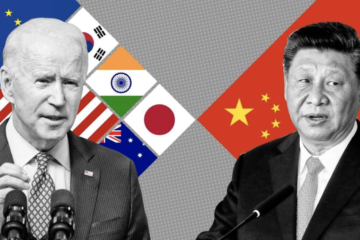There are nascent signs of thawing relations amidst the protracted US-China trade war. With US President Donald Trump’s recent offer for a ‘meeting plus dinner’ with his Chinese counterpart Xi Jinping, the prospects seem rosy for an alleviation of bilateral tensions, and for the trade war, a potential truce. Yet, such hopeful signs are fundamentally symbolic rather than substantive.
The trade war is the result of a larger array of strategic tensions, meaning that even a deal on tariffs to end the trade war could not guarantee the end of Trump’s persistence in maintaining and antagonistic stance towards China. Both countries need to find common ground from which to anchor stable relations ahead.
Expected persistence of US strategic rivalry with China
The latest boost of optimism in trade war watchers came with Trump’s offer to host a dinner with Xi Jinping after the G20 summit in Buenos Aires next month. To follow, in his latest address at the China International Import Expo, Xi emphasised China’s dedication to ‘openness’ as an actor in international trade; Xi, however, made no reference to the trade war with the US nor did he reveal any specific plan to meet Trump in Argentina. While these gestures indicate some willingness to engage from both sides to overcome the current impasse, the evidence up to this point suggests that the counteracting momentum is considerable.
The Trump administration has placed the trade war side-by-side with rhetoric on intellectual property theft and US national security. This suggests that the root of the trade war extends far beyond economics and, rather, is knotted into a messy contest for global power. The increasingly broad arena in which the Chinese threat is perceived by American leadership will not help to diffuse tensions.
The US National Defense Authorization Act was passed and signed into law in August, pointing to a ‘whole of government’ American counter-effort to combat the challenge of rising Chinese soft power. The Act bans language training at Confucius Institutes — allegedly connected closely to the Chinese government — and calls for the annual report to Congress on China to include details on Chinese espionage and Chinese attempts to influence US citizens through various channels — including media, cultural institutions, business groups, and academia. It further stipulates an increase in US defence spending, militarization in the Asia Pacific, strengthening of US-Taiwan defence cooperation as well as enhanced development of Artificial Intelligence (AI) technologies and space power.
The US also approved of a sale of arms worth $330 million to Taiwan which was essential for Taiwan’s air defence power and launched an FBI sting operation which ended up with a Chinese Ministry of Public Security official being arrested in Belgium for economic espionage — purportedly stealing trade secrets from US aerospace companies. Both of these developments, which took place in September and October respectively, elicited heated criticism from the Chinese Foreign Ministry.
For the Trump administration, the concept of national security has come to include the security of America’s position as the global economic leader. At the end of October, the US Commerce Department issued a requirement for American businesses to have a special license to export all “commodities, software and technology” to the Chinese semiconductor manufacturer Fujian Jinhua Integrated Circuit. This export ban is not only enforced on grounds of intellectual property theft, but more importantly, it also prevents Fujian Jinhua’s new plant in Jinjiang City from threatening “the long-term economic viability of US suppliers of these essential components of US military systems” by producing DRAM memory chips in sufficient scale and at low-enough cost to saturate the global market.
Fresh results from the mid-term elections do not change the ballot. While the passage of bills into laws requires both chambers’ approval, both the Republicans and the Democrats support a tougher stance on China and agree on trade-related issues, support for Taiwan, and curbing Chinese influence in the South China Sea. Now with a Democratic majority in the House of Representatives and Republican control of the Senate, a harder stance on China is expected to be sustained. Thus, although Trump enjoys executive power on trade issues — being able to set policy terms regardless of whether the Congress is divided or not — there is no lack of support in sight.
Much of recent hopes was tied to the proceeding of the second annual US-China Diplomatic and Security Dialogue, one of the four new dialogue pillars announced in April 2017. As the first among the four pillars to launch a second round in 2018, it carried high stakes to act as a stabilizing mechanism amid escalating bilateral tensions. The key issue laid with whether or not an understanding on military relations in the South China Sea could be established. Yet the conclusion of the bilateral talks last Friday was anticlimactic, as Beijing and Washington largely talked past each other, continuing to hold starkly different positions on freedom of navigation and militarization in the region.

The wider implications of the US-China trade war
Even in the thick of the trade war, US economic performance remains robust. Yet, this trend is under threat as rising inflationary pressure and prices for domestic consumers in the US become more pronounced with the second and potential third round of tariffs on Chinese imports. Moreover, increasingly icy relations would likely push the two major economies to rely less on each other and instead turn to other markets and sources of imports.
One US advantage lies in Chinese inability to use trade dependency of the domestic US market as leverage for concessions. But this is undermined by the prospect that China would become a more competitive economy itself as it advances integration with other major economic blocs. Exports from the European Union (EU) to Asia was larger than that to the US in 2017, and exports between EU and Asia are growing fast in both directions. Thus, potentially, a protracted trade war between the US and China would catalyse economic cooperation between the EU and Asia, leaving the US behind.
On the flip-side, China too has its own economic woes. An economic slowdown with growing traction exacerbated by the trade war reduced China’s real GDP growth to 6.5% in the third quarter of the year — also the lowest quarterly rate since 2009. Aside from the burden of tariffs and intellectual property charges imposed by the US, slowing investment and a rapidly ageing population, plus a debt-to-GDP ratio that has grown steadily to about 250% are all factors behind the slowdown.
These pressures increasingly push Beijing to make lasting structural changes that would make its economy more appealing to foreign investors and thus more competitive in the long run. China’s stable growth potential resides in an economic transformation from an interventionist state that privileges certain sectors, as characteristic of the ‘Made in China 2025’, to one driven by domestic innovation and further market liberalization. A greater opening of the Chinese economy, rather than further debt-financed investment in infrastructure, would make economic cooperation with China more attractive for markets such as the EU. Arguably, if on one hand the trade war will make it more difficult for China to engage in structural reforms in the short term, it could however trigger China’s cooperation towards domestic economic reforms and technological innovation with other countries besides the US.
In light of the trade war, Chinese manufacturers are offshoring their facilities. The largest beneficiaries will be the Association of Southeast Asian Nations (ASEAN), thanks to the mobilization of idle industrial capacity. This is in line with Chinese hopes for greater economic integration with the region as part of its Belt and Road Initiative. Greater economic collaboration and regional trust from ASEAN would also contribute to settling dispute in the South China Sea, mitigating the US threat. US-China strategic rivalry has indeed already begun with Chinese President Xi, Chinese Premier Li Keqiang and US Vice-President Mike Pence’s diplomatic visits to the Asia-Pacific region this week.
Economic pressures give greater urgency to conclude a truce in the trade war; nevertheless, tension will remain so long as strategic rivalry is not resolved. Improved Sino-US relations will thus rely upon an anchor of common ground between the two countries — manifesting in the past as a common threat in the Soviet Union, or in shared economic interests in the late 1990s. Realisation of this understanding, and the demonstration of a willingness to concede will be the key steps to resumed engagement between the US and China. And whether this takes the form of structural reform in the Chinese economy or a stepping back of antagonistic US rhetoric, there is much more to watch in US-China relations than the to-and-fro of the trade war.


